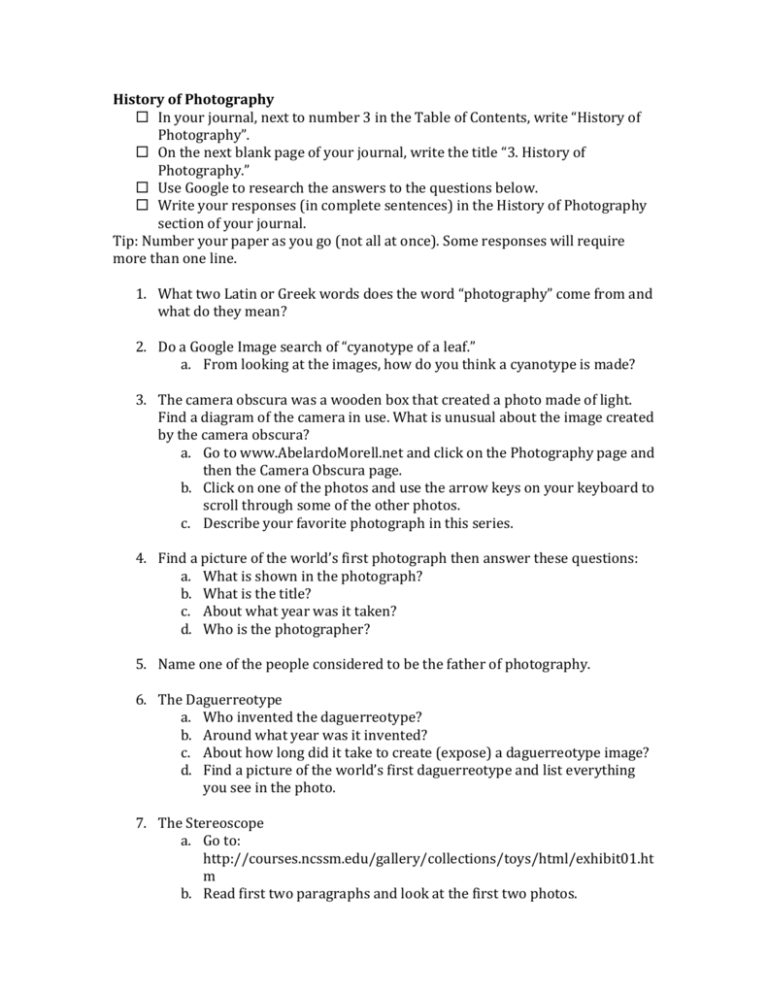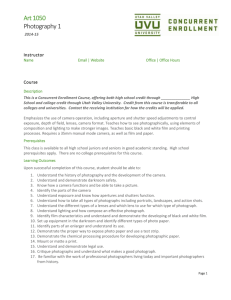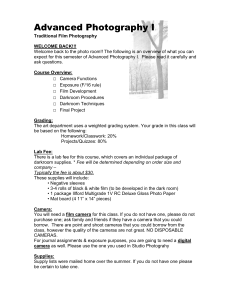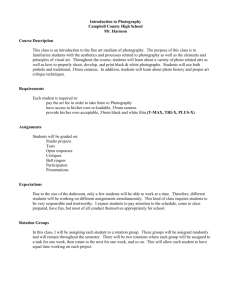File
advertisement

History of Photography In your journal, next to number 3 in the Table of Contents, write “History of Photography”. On the next blank page of your journal, write the title “3. History of Photography.” Use Google to research the answers to the questions below. Write your responses (in complete sentences) in the History of Photography section of your journal. Tip: Number your paper as you go (not all at once). Some responses will require more than one line. 1. What two Latin or Greek words does the word “photography” come from and what do they mean? 2. Do a Google Image search of “cyanotype of a leaf.” a. From looking at the images, how do you think a cyanotype is made? 3. The camera obscura was a wooden box that created a photo made of light. Find a diagram of the camera in use. What is unusual about the image created by the camera obscura? a. Go to www.AbelardoMorell.net and click on the Photography page and then the Camera Obscura page. b. Click on one of the photos and use the arrow keys on your keyboard to scroll through some of the other photos. c. Describe your favorite photograph in this series. 4. Find a picture of the world’s first photograph then answer these questions: a. What is shown in the photograph? b. What is the title? c. About what year was it taken? d. Who is the photographer? 5. Name one of the people considered to be the father of photography. 6. The Daguerreotype a. Who invented the daguerreotype? b. Around what year was it invented? c. About how long did it take to create (expose) a daguerreotype image? d. Find a picture of the world’s first daguerreotype and list everything you see in the photo. 7. The Stereoscope a. Go to: http://courses.ncssm.edu/gallery/collections/toys/html/exhibit01.ht m b. Read first two paragraphs and look at the first two photos. c. Find the stereoscopic photographs in our classroom and write what they show. 8. A “carta de visite” was a small photograph that many people carried around with them. Go ask Ms. Beckman to look at real examples of them. Be sure to look at both the front and back of the cards to get answers to these questions: a. What were these photographs of? b. What was the purpose of these cards (what did people do with them)? 9. The backs of many portrait photographs from the late 1800s and early 1900s had advertisements for the photographers. Many of these photographers also created painted portraits of people. Why do you think that is? 10. Muybridge a. Go to this website: http://www.neatorama.com/2006/08/29/thewonderful-world-of-early-photography/#!bNM48g b. Scroll slowly down the whole page and read about things that interest you (there is lots of interesting stuff!). Then go back up to the animation of the horse (it might just appear as a photo instead of an animation). Read the two paragraphs under it and answer these questions: i. Who was the photographer? ii. What year were these photos taken? iii. Describe how the photos were taken. iv. Do a Google image search for “Muybridge galloping horse” so you can see the photos individually. 11. Go to the white shelves on the History of Photography wall in the classroom. a. Pick up the Zoetrope and hold it at eye level so you can see the horse through the slots on the top. b. Spin the Zoetrope and to see what happens to the horse. c. Put the Zoetrope back where you found it. d. What did you see the horse do? 12. Where does the phrase “watch the birdie” come from? 13. Why were mothers in the Victorian era sometimes camouflaged in portraits of their children? 14. How did people get color in photographs before color photography was invented? The answer is simple…it’s not a photographic process and you don’t even need to research this to know the answer. If you had a black and white photo in your hands, what could you do with it to make it color (without using a computer)? (Hint: There is an example in the classroom from the late 1800’s/early 1900’s) 15. Go to Ms. Beckman and ask her demonstrate how to wind film into a 35mm film camera. Write down what kind of camera she uses for the demonstration. 16. What is a darkroom used for? 17. What is the red light in a darkroom called? a. I have one in the room. Can you find it and write where it is? 18. When developing 35mm film (the film used in the average person’s camera), the film had to be pulled out of the canister it came in, cut off, wound onto a film reel, and stored in a light-proof film tank. And all this had to be done in the dark! At this point, the lights could come back on and chemicals could be poured in and out of the tank but, since it was light-proof, no light could get into the tank. Once the film was developed (so you could see the negative images on it), the film was hung in a long strip in a film dryer for about two days and then the film was cut into strips. a. Find the film canister, film reel, and film tank in the room and write what company made the film that we have on display. 19. Go to the teacher’s desk and look at the negatives and slides on the light box. Please be very careful with all the negatives because some are very old and delicate and some are made of glass. Please do not take the negatives out of the plastic sleeves. a. Write down what you see in one of the negatives. b. What is the difference between a slide and a negative? 20. What is a darkroom enlarger used for? 21. Google “how to set up a darkroom.” How many baths do you have to put the photo paper through in order to develop the photo? 22. Do a Google Image search for “contact sheet.” Based on what you see, what do you think a contact sheet is and why would a photographer make one? a. Find the contact sheet in the classroom. What year is it from? 23. Mute the sound on your computer. If you don’t know how, ask your neighbor to help. a. Go to the website below: b. http://www.kodak.com/US/en/corp/features/brownieCam/ c. Click on the following pages and read each one: i. Brownie @ 100 ii. The Brownie Name iii. The First Brownies iv. Birth of a Snapshot d. Why was the Brownie important to the average American? e. How many Brownies do we have in our classroom? (Hint: They are all in the same place.) f. In what years were our Brownies made? 24. What was unique about the photos from a Polaroid camera? 25. What famous photography company went bankrupt when they didn’t convert to digital cameras? 26. What company did Steven Sasson work for when he invented the first digital camera in 1975? 27. Go to these two websites: a. http://www.usa.canon.com/cusa/consumer/products/cameras/slr_c ameras b. http://www.nikonusa.com/en/Nikon-Products/dslrcameras/index.page c. Write the names and prices of the most expensive camera on each page. 28. Go to these websites: a. http://www.usa.canon.com/cusa/consumer/products/cameras/ef_le ns_lineup b. http://www.nikonusa.com/en/Nikon-Products/CameraLenses/Sports-and-Action/index.page c. Write the name and price of the most expensive lens on each page. 29. What year was Photoshop released to the public? 30. When you blow up a film photograph really big you can see the film grain. When you blow up a digital photograph really big you can see the _________. Fun Fact: Today we take more photos in 2 minutes than all the photos that were taken in all of the 1800’s. When you have completed all 30 questions, go back to the Assignments page of our website for instruction on what to do next.






